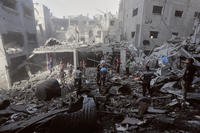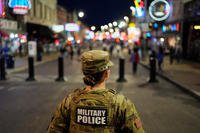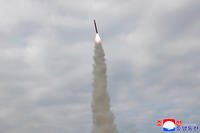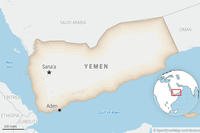The leader of the Islamic State group killed in an overnight raid in Syria detonated a suicide bomb that killed himself, his wife and two children as special operations forces circled his compound, the head of U.S. Central Command said Thursday.
The mission's goal was to capture Abu Ibrahim al-Hashimi al-Qurayshi -- also known as both Hajii Abdullah and Amir Muhammad Sa’id Abdal-Rahman al-Mawla -- the leader of the terror group since 2019, but the "massive" blast early in the two-hour raid leveled the third story of the compound where he and his family were hiding out, Gen. Frank McKenzie said. That was followed later by a firefight with al-Qaida members who arrived at the site.
U.S. troops had surrounded the building in Syria's northwestern Idlib province and were using a loudspeaker to call on the ISIS leader and civilians inside to evacuate and surrender, according to McKenzie and accounts by the Pentagon. Hajii Abdullah, his three family members, and a child who was on the second floor were all killed during the raid, they said, but outside monitoring organizations put the death toll at 13.
Read Next: Traumatic Brain Injury Classifications Are Leading to Preventable Deaths, Report Says
No U.S. troops were reported to be injured or killed, but a military helicopter was destroyed by special operators after making an emergency landing after the raid.
"Let me be very clear. Hajii Abdullah did not fight. He killed himself and his immediate family without fighting, even as we attempted to call for his surrender and offered him a path to survive," McKenzie said during an appearance at the Middle East Institute.

Hajii Abdullah led the terror group as it has attempted a comeback, including a major attack in January on a Syrian prison holding its operatives, after going to ground for years following a punishing U.S.-coalition air war in Iraq and Syria. The terror network he controlled included ISIS branches around the world, from Africa to Afghanistan, according to a senior administration official who spoke on background.
Defense Secretary Lloyd Austin said Hajii Abdullah "provided near-constant operational guidance to ISIS fighters, to include the prison break and attack at Hasakah and the slaughter of Yazidis in Iraq."
He took over ISIS after the previous leader, Abu Bakr al-Baghdadi, was killed during a U.S. raid in northwestern Syria in 2019. Al-Baghdadi also detonated a suicide vest after he was chased into a tunnel, killing himself and his children.
"While Baghdadi was iconic and a philosopher figure in ISIS, this guy was actually far more of an operational planner and a director of operations," McKenzie said of Hajii Abdullah.
McKenzie said the objective was to capture the ISIS leader, but he did not say what the U.S. planned to do with him if the mission succeeded.
The long-range helicopter raid had been planned for months before it was finally authorized by President Joe Biden on Tuesday morning during a meeting with Austin and Gen. Mark Milley, the Joint Chiefs chairman, the senior administration official said. Biden was given an in-depth briefing more than a month ago after the U.S. confirmed the ISIS leader was at the site, and updated regularly.
The special operations force, which was not identified by the Pentagon, surrounded the compound and was able to evacuate six civilians from the first floor of the building when the suicide bomb detonated, McKenzie said.

"The explosion, which was more massive than would be expected from a suicide vest, killed everyone on the third floor and, in fact, ejected multiple people from the building, including Hajii Abdullah," he said.
Biden was monitoring the unfolding raid from the White House Situation Room, along with Austin, Milley and McKenzie.
Troops moved into the building and found the ISIS leader's two lieutenants barricaded among children on the second floor. The fighters were killed, and special operators safely evacuated four children, including an infant. Another child was found dead on that floor.
Outside groups gave conflicting early reports of civilian deaths at the scene. The Syrian Civil Defense, known as the White Helmets, said 13 people were killed, and the Syrian Observatory for Human Rights, based in the U.K., also said the strike killed 13 people, including four children and two women, according to The Associated Press.
"We'll look into whether any unintended harm resulted from U.S. actions," McKenzie said. "I don't believe that to be the case as I speak right now, but as always, we'll take a look at it because it's been less than 24 hours since the operation was executed."
As forces cleared the building, multiple armed fighters believed to be members of a local affiliate of the al-Qaida terrorist group descended on the compound. A U.S. helicopter turned its guns on the attackers, killing at least two.
Hajii Abdullah's body was found on the ground outside the building, and he was identified by fingerprint analysis on site and later DNA analysis, according to McKenzie and the Pentagon.

A helicopter used in the raid experienced what the Pentagon described as a mechanical "drive train issue." It was safely landed, and the crew evacuated before it was rigged with explosives and destroyed so no sensitive U.S. equipment was left in Syria, McKenzie said.
The deaths of the women and children in the Syria raid come just a week after Austin ordered the Pentagon to overhaul its efforts to prevent civilian casualties in overseas operations. A drone strike in Kabul on Aug. 29, 2021, during the withdrawal from Afghanistan killed 10 civilians, including children, and a 2019 airstrike in Baghuz, Syria, killed 70 civilians, including mostly women and children, according to a New York Times investigation.
Biden and the Pentagon said the decision to send in special operators instead of an airstrike was made specifically to limit the risk of civilian harm, and that the troops on the ground did everything possible to keep noncombatants on the ground safe.
"The strong indications are that the lives of innocents taken in this operation were caused by Abdullah and his decision of blowing himself up and everybody else with him on that third floor, as well as the resistance of his lieutenant on the second floor," Pentagon spokesman John Kirby said during a briefing to reporters Thursday.
-- Travis Tritten can be reached at travis.tritten@military.com. Follow him on Twitter @Travis_Tritten.
Related: Military Ordered to Overhaul Effort to Prevent Civilian Casualties After Botched Airstrikes














